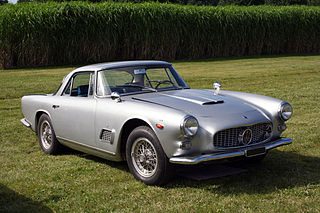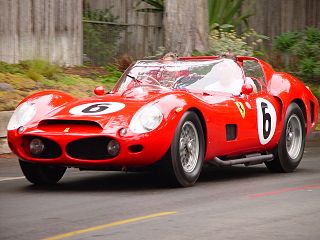
Pietro Frua was one of the leading Italian coachbuilders and car designers during the 1950s and 1960s.

Dino was a marque best known for mid-engined, rear-drive sports cars produced by Ferrari from 1957 to 1976. The marque came into existence in late 1956 with a front-engined Formula Two racer powered by a brand new Dino V6 engine. The name Dino was used for some models with engines smaller than 12 cylinders, it was an attempt by the company to offer a relatively low-cost sports car. The Ferrari name remained reserved for its premium V12 and flat-12 models until 1976, when "Dino" was retired in favour of full Ferrari branding.

The Ferrari 250 is a series of sports cars and grand tourers built by Ferrari from 1952 to 1964. The company's most successful early line, the 250 series includes many variants designed for road use or sports car racing. 250 series cars are characterized by their use of a 3.0 L (2,953 cc) Colombo V12 engine designed by Gioacchino Colombo. They were replaced by the 275 and 330 series cars.

The Ferrari250 Testa Rossa, or 250 TR, is a racing sports car built by Ferrari from 1957 to 1961. It was introduced at the end of the 1957 racing season in response to rule changes that enforced a maximum engine displacement of 3 litres for the 24 Hours of Le Mans and World Sports Car Championship races. The 250 TR was closely related to earlier Ferrari sports cars, sharing many key components with other 250 models and the 500 TR.

The Maserati 3500 GT and the Maserati 3500 GT Spyder are 2-door coupé and convertible grand tourers made by Italian car manufacturer Maserati between 1957 and 1964. It was a seminal vehicle for Maserati as the company's first successful attempt at the Gran Turismo market and series production.

The Maserati 300S was a racing car produced by Maserati of Italy between 1955 and 1958 to compete in the FIA's World Sportscar Championship. Twenty-six examples were produced.

Maserati A6 were a series of grand tourers, racing sports cars and single seaters made by Maserati of Italy between 1947 and 1956. They were named for Alfieri Maserati and for their straight-six engine.

Medardo Fantuzzi (1906–1986) was an Italian automotive engineer, known for his Carrozzeria Fantuzzi body workshop.

The Maserati 200S is a racing car made by Italian automobile manufacturer Maserati as a successor to the Maserati A6GCS. 28 cars were made in total. The development of the 200S, codenamed Tipo 52 started in 1952, led by Vittorio Bellentani. In response to Ferrari's 500 Mondial racing car which featured a four-cylinder engine and was quite successful in sports car racing. The car had a 1,994.3 cc (2.0 L) inline-four light-alloy engine, featuring dual overhead valves per cylinder and twin camshafts, double Weber 50DCO3 or 45DCO3 carburetors. The engine was rated at 190 PS at 7,500 rpm. Many chassis components were identical to the Maserati 150S in order to speed up development, except the rigid rear axle inherited from the Maserati A6.

Maserati 150S is a racing car made by Maserati of Italy alongside the Maserati 200S, to take over for the aging Maserati A6GCS racing variants. Depending on the source, between twenty-four and twenty-seven examples were built, and one additional street-going car, called the Maserati 150 GT.

The Maserati Tipo 60/61 are a series of sports racing cars produced between 1959 and 1961 by Italian automobile manufacturer Maserati for privateers racing in sports car events including the 24 Hours of Le Mans in the 2-litre and 3-litre racing category. It used an intricate tubular space frame chassis, containing about 200 chro-moly steel tubes welded together, arranged triangular formation at high stress areas of the chassis, hence the nickname "Birdcage". This method of construction provided a more rigid and, at the same time, lighter chassis than other racing cars of the time.
Throughout its history, the Italian auto manufacturer Maserati has participated in various forms of motorsports including Formula One, sportscar racing and touring car racing, both as a works team and through private entrants.

The Maserati 250S, and its derivative and version, the 250 Sport, are sports racing cars, designed, developed and built by Italian car manufacturer Maserati, between 1954 and 1957. Only two models were produced.
Neri and Bonacini, also known as Nembo, was a small carrozzeria and mechanic shop based in Modena, Italy, active from the late 1950s to around 1967. Founded and run by Giorgio Neri and Luciano Bonacini, the shop worked on and produced bodies for Ferrari, Lamborghini and Maserati road and race cars, both in an official capacity for those manufacturers and for private owners. Their best known projects are the Ferrari 250 GT-based Nembo spiders and the Lamborghini 400GT Monza. Neri and Bonacini also designed a car under their own name, the Neri and Bonacini Studio GT Due Litri. Two prototypes of this car were made between 1966 and 1968 but it never entered series production. The shop closed around 1967 when Bonacini went to work for De Tomaso and Neri started his own shop, Motors-World-Machines (MWM).

The Ferrari 330 TRI/LM Spyder is a unique racing sports car purpose-built in 1962 by Ferrari to achieve victory at the 24 Hours of Le Mans. It was the last Ferrari racing sports car with a front-mounted engine and the last of a series of Ferrari race cars known as the Testa Rossas. The "I" in its designation indicates that the car has an independent rear suspension.

The Ferrari SP was a series of Italian sports prototype racing cars produced by Ferrari during the early 1960s. All featured a rear mid-engine layout, a first for a Ferrari sports car. Major racing accolades include the 1962 European Hill Climb Championship, two overall Targa Florio victories, in 1961 and 1962, and "1962 Coupe des Sports" title.

The Maserati 420M/58Eldorado was a single-seater manufactured by Maserati in 1958. It was a one-off race car purpose-built for the second edition of the 500 Miles of Monza. It was the first single-seater in Europe to be sponsored by a brand not attached to an automobile industry. The internal Maserati classification was the Tipo 4, behind the 250F variants, and also referred to as the 420/M/58 for 4.2-litre displacement, Monoposto or a single-seater in Italian and 1958 year, or simply as the "Eldorado".
Thomas Meade was an American automobile designer and dealer best known for his Thomassima series of custom cars based on Ferrari engines and chassis. He was based in Modena, Italy from the early 1960s through the early 1970s, where he met and collaborated with many Modenese carrozzerie, manufacturers and mechanics.
Maserati has made three inline-4 racing engines, that were designed for both Formula One and Sports car racing. Their first engine was the supercharged 4CLT engine in 1950; with the 1.5 L engine configuration imposed by the FIA for engines with forced induction. Their second engine was the naturally-aspirated 250S engine; with the 2.5 L engine configuration, and was used by Cooper and JBW. Their third and final engine was the naturally-aspirated Tipo 6-1500; with the 1.5 L engine configuration, and the customer engine was used by Cooper, Emeryson, Lotus, and E.N.B. teams.
Maserati made two naturally-aspirated, straight-6, racing engines, designed for Formula One; between 1952 and 1960. The first engine was the 2.0-liter A6G; in accordance with the engine regulations imposed by the FIA. Their second and last engine was the 250 F1; in accordance with the engine regulations imposed by the FIA for 1954. Several of these engines, or derivatives of these engines, were also used in various Maserati sports cars.

















